Fix: TeamViewer ‘Not Ready Check Your Connection’ Error
TeamViewer is a useful program for video chats and remote control and it’s quite a popular choice among gamers and remote IT assistance. However, many users have reported that they are simply not able to connect. They see the problematic error message at the bottom of their screen, next to red light.
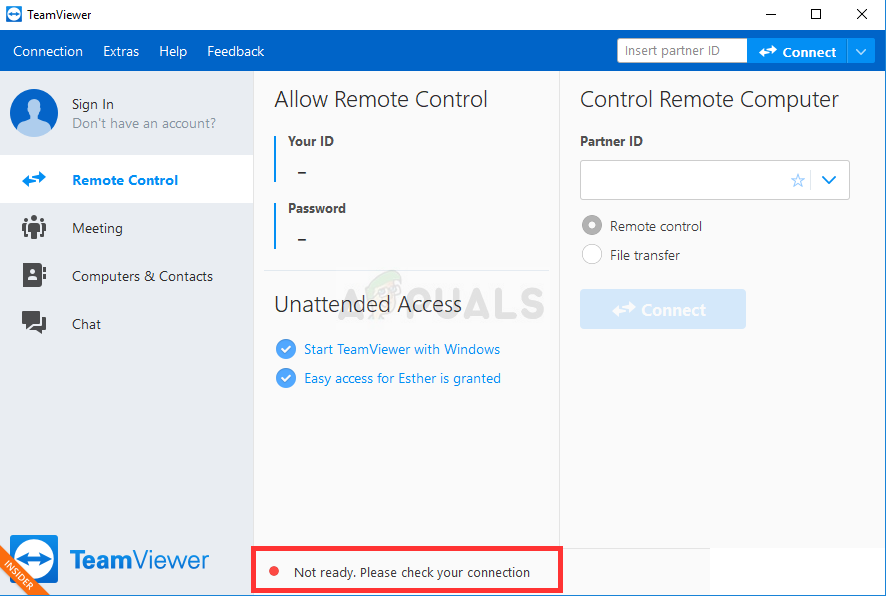
There are quite a few methods you can use to resolve the problem and we suggest you check them out below. They are usually quite easy to perform and they can resolve your problem in an instant!
What Causes the TeamViewer “Not Ready Check Your Connection” Error on Windows?
This particular problem has many different causes and pinpointing the correct one may be crucial if you don’t want to try out every method on the list. This will guide you to the solution faster and that is why we decided to create the list of all possible causes located below!
- Wrong settings in the ‘hosts’ file – The ‘hosts’ file contains important information about apps connecting to the Internet and it’s possible that the entry for TeamViewer got corrupted. Deleting its entry will cause Windows to re-create it so try that to resolve the problem.
- Antivirus or firewall issues – If TeamViewer’s access to the Internet is prevented by the firewall or antivirus you have running, make sure you try making an exception for its main executable file.
- DNS and Winsock issues – DNS addresses can be changed and Winsock can be reset. For many users, this is all it took to resolve the problem so make sure you try it out!
- IPv6 connectivity – TeamViewer simply won’t work on IPv6 sometimes so make sure you consider disabling it for the sake of resolving this problem. It won’t hurt and it may bring TeamViewer back!
- TeamViewer’s new interface – The user interface is not something which should be related to connectivity problems but it was certainly the case for several TeamViewer users. Reverting to the old interface managed to resolve the problem for them.
Solution 1: Remove TeamViewer from the Hosts File
It’s highly likely that the TeamViewer entry in the ‘hosts’ file on your computer has been corrupted. It might show addresses and data which is completely wrong and we suggest you delete its entry. Once you reopen it, the entry will be recreated and the problem would hopefully cease to appear!
- Navigate to the location C >> Windows >> System32 >> Drivers >> Etc by navigating to it after opening the File Explorer. First, click This PC or My Computer from the left side pane to locate and open your Local Disk C.
- If you are unable to see the Windows folder, you may need to turn on the option which enables you to see hidden files and folders. Click the “View” tab in File Explorer’s top menu and click the “Hidden items” checkbox in the Show/hide File Explorer will show the hidden files and will remember this setting until you change it again.

- Locate the hosts file in the Etc folder, right-click on it, and choose to Open with Notepad. Use the Ctrl + F key combination and make sure you enter ‘teamviewer’ in the Find what box before clicking the Find next
- Locate the TeamViewer section in the file. It should start with “#Teamviewer” and make sure you select everything that belongs to it, right-click the selection, and choose the Delete button from the context menu.
- Click File >> Save to save the changes or use the Ctrl + S key combination. Exit Notepad and restart your computer. Check to see if the problem persists regarding the TeamViewer “Not ready. Check your connection” error message!
Solution 2: Change Your DNS Address
Users have said that they were able to resolve the issue simply by changing the DNS provided by your ISP (Internet Service Provider) and starting to use a different one. It can be a DNS of a computer where the issue doesn’t appear but many users simply used Google’s DNS to resolve the problem. Follow the steps below to change the DNS address on your computer!
- Use the Windows + R key combination which should open the Run utility box where you should type ‘ncpa.cpl’ in the text box and click OK to open the Internet Connection Settings entry in Control Panel.
- The same thing can be done simply by manually opening the Control Panel. Switch the View by option at the top right section of the window to Category and click on Network and Internet at the top. Click the Network and Sharing Center button to open it before managing to locate the Change adapter settings button at the left menu and click on it.
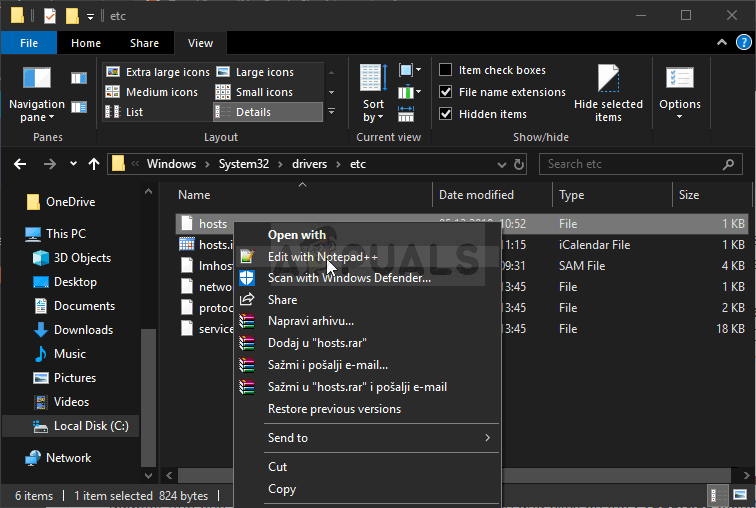
Edit the Hosts file - Now that the Internet Connection screen is open using any method above, double-click your active network adapter (the one you are using to connect to the Internet) and click on the Properties button below if you have admin permissions for the current user account.
- Locate the Internet Protocol Version 4 (TCP/IPv4) item on the list. Click on it to select it and click the Properties button below.

Opening IPv4 Properties - Stay in the General tab and change the radio button in the Properties window to “Use the following DNS server addresses” if it was set to the other option.
- Either way, set the Preferred DNS server to be 8.8.8.8 and the Alternate DNS server to be 8.8.4.4.

Setting the DNS address - Keep the “Validate settings upon exit” option checked and click OK to apply the changes immediately. Check to see if the TeamViewer “Not ready. Check your connection” error message still appears on your computer!
Solution 3: Reset Winsock
“netsh Winsock reset” is a helpful command that you can use in Command Prompt to reset Winsock Catalog back to default setting or its clean state. You can try this method if you are experiencing the inability to connect in TeamViewer.
- Search for “Command Prompt” by typing it either right in the Start menu or by pressing the search button right next to it. Right-click the first entry which will pop up as a search result and select the “Run as administrator” context menu entry.
- Additionally, you can also use the Windows Logo Key + R key combination to bring up the Run dialog box. Type in “cmd” in the dialog box which appears and use the Ctrl + Shift + Enter key combination to run Command Prompt using administrator privileges.
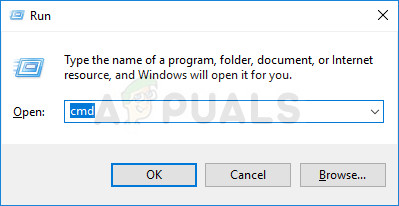
Running Command Prompt - Type in the following commands in the window and make sure you press Enter after typing each one. Wait for the “Winsock reset completed successfully” message or something similar to know that the method has worked and you haven’t made any mistakes while typing. Check to see if the issue persists.
netsh winsock reset netsh int ip reset

Solution 4: Don’t Use the New User Interface
User interface shouldn’t be in any way connected to TeamViewer’s internet connection but, weirdly enough, many users have reported that they were able to resolve this issue simply by reverting to the program’s old design. This can be done in TeamViewer’s settings so make sure you follow the steps below and try to resolve this connectivity issue.
- Open TeamViewer by double-clicking its icon from Desktop or by searching for it after opening the Start menu and left-clicking the top result.
- From the home screen, click the Extras button from the menu bar and choose the Options entry from the list which will appear.

TeamViewer options - Navigate to the Advanced tab in TeamViewer options from the left-side navigation menu and check under General Advanced Settings for the “Use new user interface” option. Make sure you uncheck the box next to it before confirming the changes you have made.
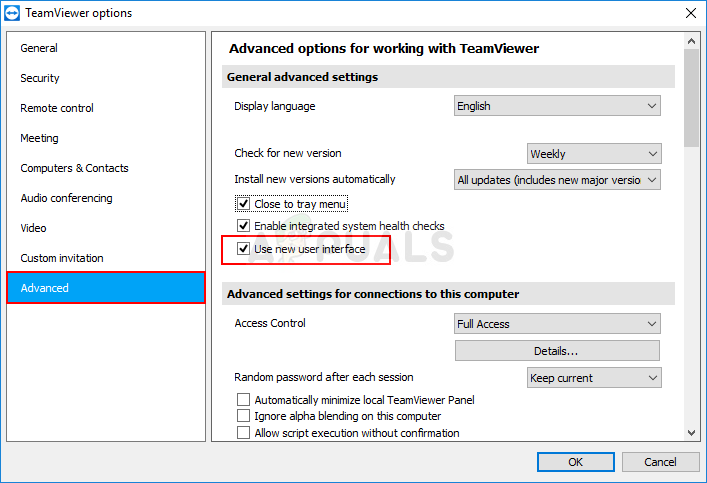
Uncheck this box - Reopen TeamViewer and check to see if the TeamViewer “Not ready. Check your connection” error message still appears on your computer!
Solution 5: Add an Exception for the Teamviewer_Service.exe File
Sometimes antivirus tools fail to recognize the program’s efforts to connect to the Internet as harmless and TeamViewer’s features are often blocked by it. To prove to the antivirus that the program is harmless, you will have to add it to its Exceptions/Exclusions list!
- Open the antivirus user interface by double-clicking on its icon at the system tray (right part of the taskbar at the bottom of the window) or by searching for it in the Start menu.
- The Exceptions or Exclusions setting is located in different spots concerning different antivirus tools. It can often be found simply without much hassle but here are some quick guides on how to find it in the most popular antivirus tools:
Kaspersky Internet Security: Home >> Settings >> Additional >> Threats and Exclusions >> Exclusions >> Specify Trusted Applications >> Add.

Kaspersky Exclusions AVG: Home >> Settings >> Components >> Web Shield >> Exceptions.

AVG Exceptions Avast: Home >> Settings >> General >> Exclusions- You will need to add the Teamviewer_Service.exe executable in the box which will appear prompting you to navigate to the folder. It should be in the same folder where you decided to install TeamViewer in. By default, it’s:
C:\Program Files (x86)\TeamViewer
- Check to see if you are now able to use TeamViewer without receiving the problematic error message. If it still won’t work, try restarting your computer and try again. The last step would be to uninstall the antivirus and try a different one if the problem persists.
Solution 6: Allow it in Windows Defender Firewall
For TeamViewer’s features to work properly, the app needs to have uninterrupted access to the Internet and its servers to work properly. Windows Defender Firewall is often to blame in such cases and we recommend you make an exception for the Teamviewer_Service.exe executable inside the Windows Defender Firewall!
- Open up Control Panel by searching for the utility in the Start button or by clicking the Search button or the Cortana button at the left part of your taskbar (bottom left part of your screen).
- After Control Panel opens, change the view to Large or Small icons and navigate to the bottom to open the Windows Defender Firewall option.

Opening Windows Defender Firewall - Click on Windows Defender Firewall and click on the Allow an app or feature through Windows Firewall option from the left side list of options. A list of installed apps should open. Click the Change settings button at the top of the screen and provide administrator permissions. Try locating the executable inside. If it’s not there, click the Allow another app button below.

Allowing an app through - Navigate to where you installed TeamViewer (C:\Program Files (x86)\TeamViewer by default) and choose the Teamviewer_Service.exe file.
- After locating it, click the Network types button at the top and make sure you check the boxes next to both Private and Public entries before clicking OK >> Add.

Network types - Click OK and restart your computer before checking whether the TeamViewer “Not ready. Check your connection” error message still appears on your computer.
Solution 7: Disable IPv6
Disabling Internet Protocol version 6 connectivity on your computer managed to resolve the problem for many users and it’s an easy way to resolve the problem. This makes this method worthy and you shouldn’t skip it during your troubleshooting process.
- Use the Windows + R key combo which should immediately open the Run dialog box where you should type ‘ncpa.cpl’ in the bar and click OK to open the Internet Connection settings item in Control Panel.
- The same process can also be done by manually opening the Control Panel. Switch the View by setting at the top right section of the window to Category and click on Network and Internet at the top. Click the Network and Sharing center button to open it. Try to locate the Change adapter settings button at the left menu and click on it.
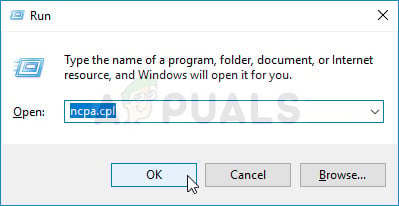
Run this command - When the Internet Connection window opens, double-click on your active Network Adapter.
- Then click Properties and locate the Internet Protocol Version 6 entry on the list. Disable the checkbox next to this entry and click OK. Restart your computer to confirm the changes and check to see if the problem persists.

Solution 8: Restart the TeamViewer Service
Stopping the TeamViewer service from running will effectively restart the whole process and many users have reported that it only took them a few minutes to get TeamViewer to work again. Before starting, make sure you have closed TeamViewer completely.
- Open the Run utility by using the Windows Key + R key combination on your keyboard (press these keys at the same time. Type “services.msc” in the newly opened box without the quotation marks and click OK to open the Services tool.

Running Services - The alternative way is to open the Control Panel by locating it in the Start menu. You can also search for it using the Start menu’s search button.
- After the Control Panel window opens, change the “View by” option at the top right part of the window to “Large Icons” and scroll down until you locate the Administrative Tools entry. Click on it and locate the Services shortcut at the bottom. Click on it to open it as well.

Opening Services in Control Panel - Locate the TeamViewer Service on the list, right-click on it and select Properties from the context menu which appears.
- If the service is started (you can check that just next to the Service status message), you should stop it for now by clicking the Stop button in the middle of the window. If it is stopped, leave it stopped until we proceed.

TeamViewer service properties - Make sure that the option under the Startup type menu in the service’s properties window is set to Automatic before you proceed with other steps. Confirm any dialogue boxes which may appear when changing the startup type. Click on the Start button in the middle of the window before exiting.
Solution 9: Reinstall TeamViewer
If all methods above fail to work, reinstalling TeamViewer is the last method which can help you resolve the problem on your computer. It should be fast and painless if you follow all the steps properly! You will also install the latest version which contains the patch to the specific issue you are having!
- Click the Start menu and open Control Panel by searching for it simply by typing with the Start menu window open. Alternatively, you can click the cog icon in the lower-left part of the Start menu to open the Settings app if you are using Windows 10.

Opening Settings in Start menu - In Control Panel, select the View as: Category option at the top right corner of the Control Panel window and click on Uninstall a Program under the Programs section.
- If you are using the Settings app, clicking on Apps should immediately open a list of all installed programs on your PC so wait for a while for it to load
- Locate TeamViewer in Control Panel or Settings and click on Uninstall/Repair. Follow any instructions which appear afterward to uninstall it completely.

Uninstalling TeamViewer - Download the latest version of TeamViewer by visiting this link. Download its setup file, run it from the Downloads folder, follow the instructions on screen, and check to see if the problem persists after reinstalling TeamViewer!





